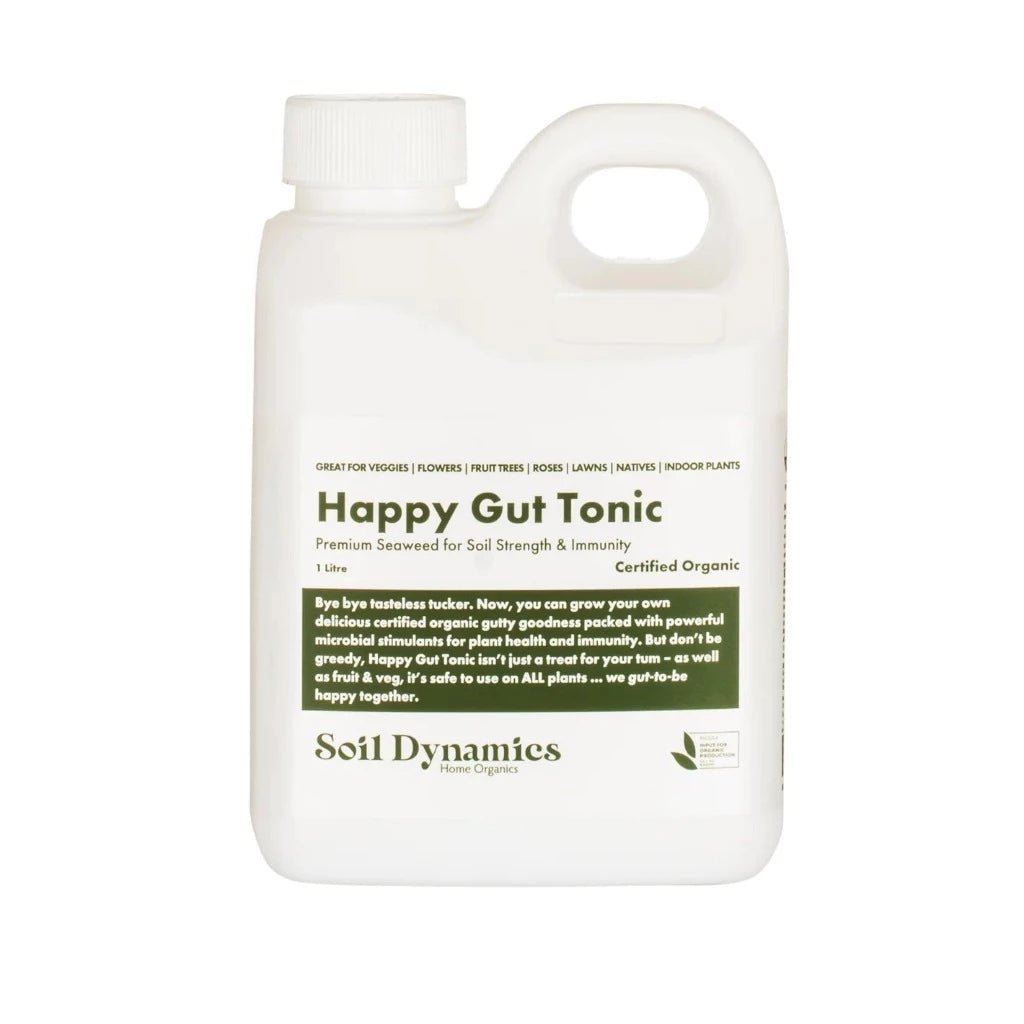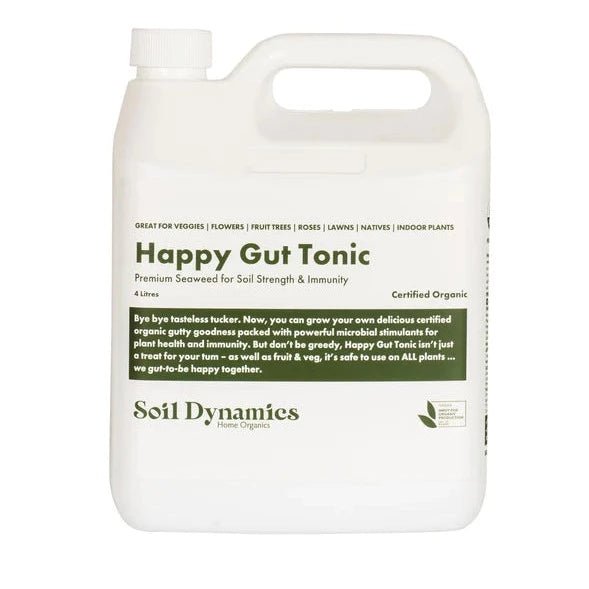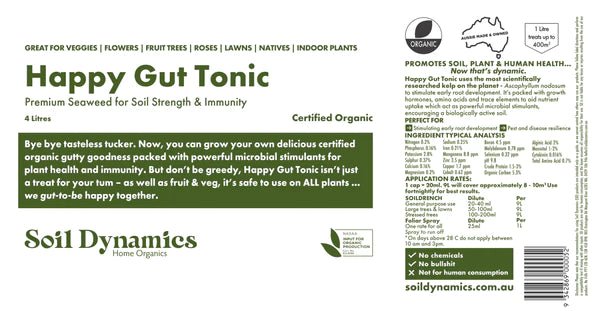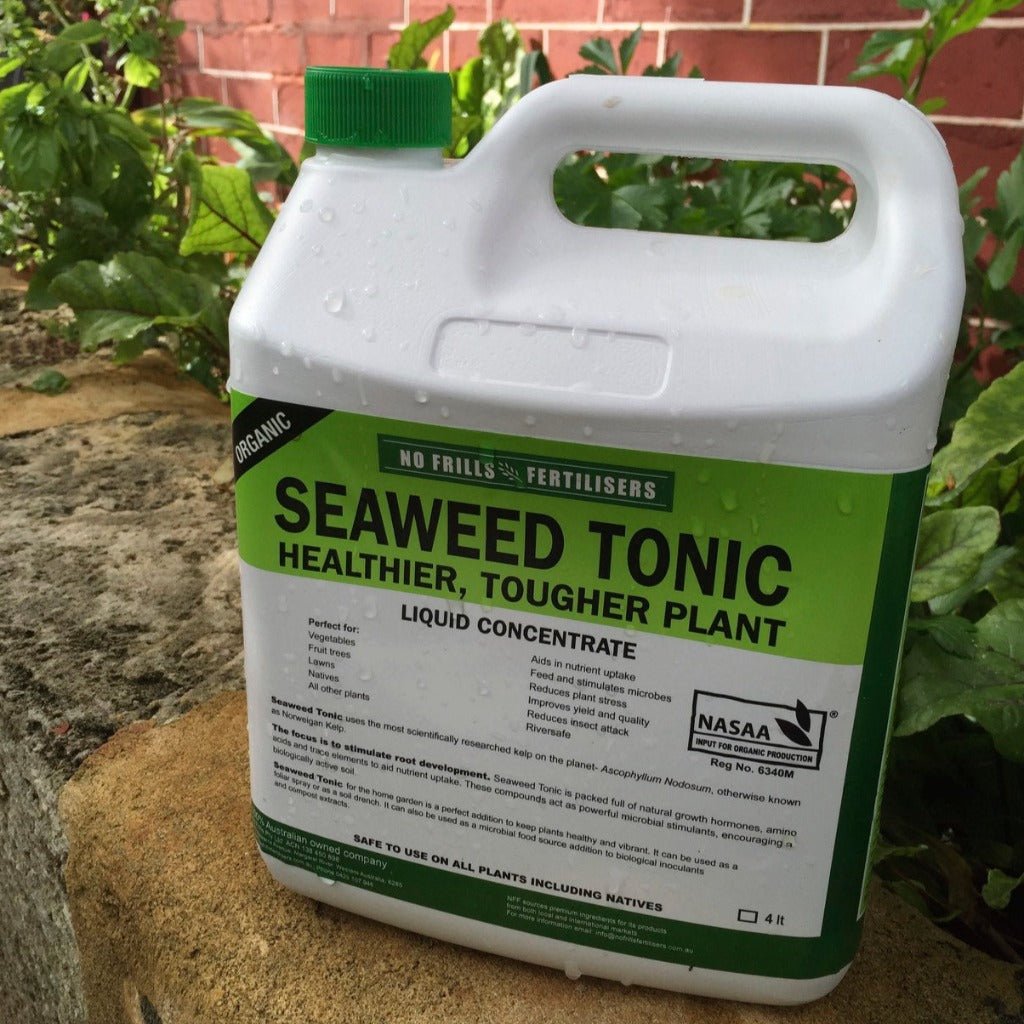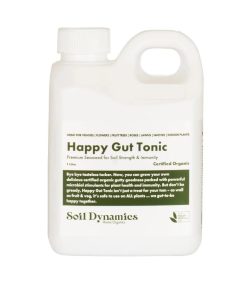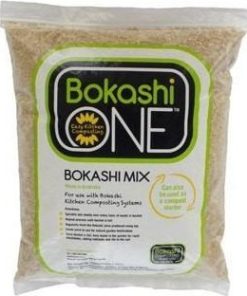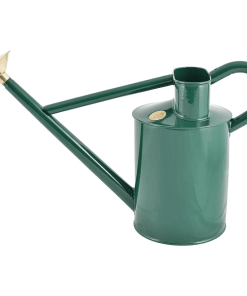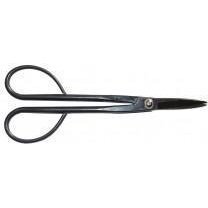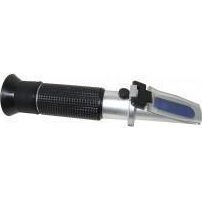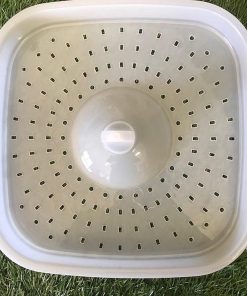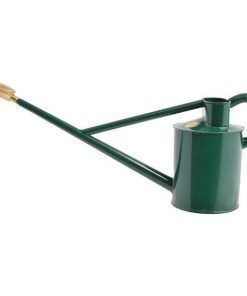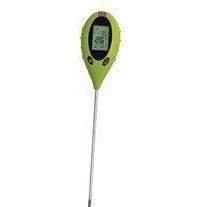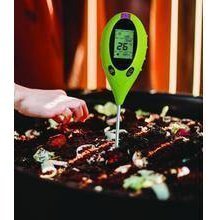Soil Dynamics “Happy Gut Tonic” Seaweed Fertiliser (formerly No Frills Seaweed Tonic) Soil Dynamics
$ 28,00 $ 16,80
Happy Gut Tonic – Certified Organic Seaweed Fertiliser:
Experience the superfood benefits of the sea for your garden with Happy Gut Tonic! (Formally known as No Frills Seaweed Tonic). This NASAA certified organic formula brings kelp and various trace elements to your plants, helping them to maintain strength and vitality. It’s not just good for the garden; a robust garden also means good health for you!
The Difference between Happy Gut Seaweed Tonic and others like seaweed fertilisers is:
- It uses the most scientifically researched kelp on the planet- Ascophyllum Nodosum.
- It is agriculture grade and covers twice the distance.
- Certified Organic by NASAA
This organic Seaweed Tonic contains alginic acid, this is a unique material that has an immediate effect on soil particles by forming bonds. It gives the soil a crumb like structure that holds and retains moisture and houses microbes.
It is perfect for stimulating root development and resilience against pests and disease in all plants.
What is it? It’s a liquid concentrate of kelp.
What does it do? It stimulates early root development and reduces plant stress.
How does it work? It acts as a powerful microbial stimulant encouraging an active soil environment and promotes plant immunity.
What are the benefits?
- Healthier tougher plants.
- Reduced plant stress.
- Stimulates microbes, improving soil health.
- River and ground safe.
- Improves plant nutrient uptake.
How to Use Happy Gut Tonic:
For New Plants:
Begin new seedlings with Happy Gut Tonic to stimulate root growth and help develop more resilient, robust plants.
Regular Use:
Organic Happy Gut Tonic should be applied every two weeks, while The Protein Shake, Jurassic Juice, and Regenerate Elixir should be used each month to deliver a range of soil and plant benefits. One person’s watering can is likely to differ from another, and our suggested application rate is based on a single watering that covers approximately 8-10 m2. The amount of concentrate used may vary based on soil conditions and stage of plant growth, but to ensure effective use:
- the plant leaves are covered to a point of runoff
- the soil area around the base of the plant has been showered
- water into the soil well if using the higher rate
- hose off any residue on leaves to prevent burning
Note: 1 level cap = 20ml. 1 standard watering can = 9 litres.
Soil Drench:
This is the most common way to use the product. Simply dilute into a watering can and apply to the plant leaves and soil surface.
Foliar Spray:
For optimal efficiency, some growers prefer to use handheld or backpack sprayers when applying products. To ensure a fine mist adequately covers leaf surfaces, dilute the product into a sprayer with water and spray until runoff is visible.
Application Rates:
Per 9L Soil Drench Foliar Spray
Garden beds 20-40mL 25mL
Large trees 50-100mL 25mL
Stressed Tress 100-200mL 25mL
Container Pots 20-40mL 25mL
Lawns 50-100mL 25mL
Natives 20-30mL 25mL
General 20-40mL 25mL
Typical Analysis:
Nitrogen 0.2% Manganese 1-6 ppm Organic matter 9-10%
Phsophorus 0.16% Zinc 2-20 ppm Alginic acid 2%
Potassium 2.8% Copper 0.2-6 ppm Mannitol 1-2%
Sulphur 0.2% Boron 2-3 ppm Cytokinin 0.012-0.016%
Calcium 0.16% Molybdenum 0.2-1 ppm Total amino acid 0.45-0.7%
Magnesium 0.04-0.2% Selenium <1 ppm Crude protein 1.5-3%
Sodium 0.25% Iron 0.21% pH 9-10
| Size | 1l, 4l |
|---|
Quick Shipping and Professional Packaging
Due to our longstanding partnership with UPS FedEx DHL as well as other top international carriers, we are able to provide a range of shipping options. Our warehouse staff are highly trained and will pack the goods according to our precise and exact specifications. Before they are shipped, your goods will be thoroughly examined and secured. We deliver to hundreds of thousands of customers every day in different countries. This demonstrates our dedication to become the biggest online retailer in the world. Both Europe and the USA have distribution and warehouse centers.
Note: Orders that contain more than one item are assigned a processing time depending on the item.
Prior to shipping, we examine the items ordered thoroughly before sending the items. The majority of orders will be shipped within 48 hours. The delivery time should be between 3 and 7 working days.
Returns
We are not able to manage the stock at our warehouse or factory. The stock levels may fluctuate at any given time. It's possible that the stocks could be depleted after the order has been made.
Our policy is valid for 30 days. Unfortunately, if the 30 days have elapsed after you bought your item, we will not be able to provide a refund or exchange.
In order for your item to be returned it must be in its original packaging, unopened and in the same state as you received it in. The item must be returned in its original packaging.
Related products
Garden
Garden
Garden
Garden
Garden
